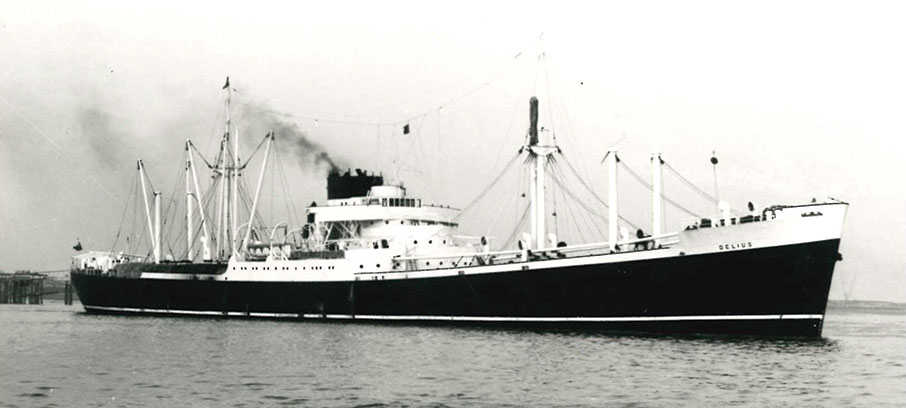
Built in Belfast by Harland & Wolff, the Lamport & Holt Line cargo liner Delius was the first of three sisterships completed between 1937 and 1945 featuring an unusually large funnel that was incorporated into the vessel's superstructure and housed the radio room and the radio officer’s accommodation. By Andrew Linington
Launched only two years before the outbreak of war, the 6,065grt vessel had an eventful time during the conflict – but managed to survive and to continue trading until 1962.
The Liverpool-registered ship was powered by a six-cylinder double-acting two-stroke Burmeister & Wain engine. The single-screw ship had a service speed of 14 knots and was built for the South American trade, which had been started by Lamport & Holt in the 1840s.
Named after the composer, Delius had three cargo holds forwards and three aft of the engineroom, and cargo was handled by 19 tubular steel derricks. The ship had accommodation for 12 passengers.
Delius was requisitioned by the UK government in the Second World War and saw service in Operation Ariel to evacuate armed forces and civilians from northern France, also taking part in the Norwegian campaign and convoy duty around the world. The ship was damaged by bombing on 27 and 29 April 1940 while in a convoy off the coast of Norway. In November 1943, while returning from a voyage to India, Delius was attacked in the Atlantic after 60 enemy aircraft targeted a convoy of 20 ships.

Named after the composer, Delius had three cargo holds and accommodation for 12 passengers. The 1937-built ship was requisitioned in the Second World War and saw a great deal of action
Reports suggest that Delius was the victim of a radio-controlled glider bomb. Gunners onboard had successfully shot one down, but the second landed on the foredeck and killed everyone on the bridge, including the captain, the second officer, the bosun, and an AB. Several other crew members were wounded, the ship was left under the command of the third mate, and a doctor was transferred from a corvette to provide first aid.
The bomb started a fire in the cotton cargo in one of the holds and water pumped in to tackle the blaze gave the ship a dangerous list to starboard. Crew members had to take turns down the hold to keep the pump suction clear.
Although Delius was left with no compass other than the ones in the lifeboats, as well as the steering gear being damaged and two of the six cylinders being out of order, the crew managed to get the ship to safety in a UK port.
After surviving the rest of the war, Delius went back to the South American service and was sold in 1954 to the Blue Star Line and renamed Portland Star. However, the ship was bareboat chartered to Lamport & Holt in 1958 and took the title Delius once again.
In 1961, the ship was sold to the French operator Compagnie Metallurgique et Miniere, renamed Kettara VII and transferred to the Panamanian flag. One year later, the vessel was sold for scrap and sailed to Tokyo for demolition in April 1962, along with sistership Delane. Two of the other 'D-boats' had been war losses and the last of the series, Defoe, was scrapped in Shanghai in 1970.
